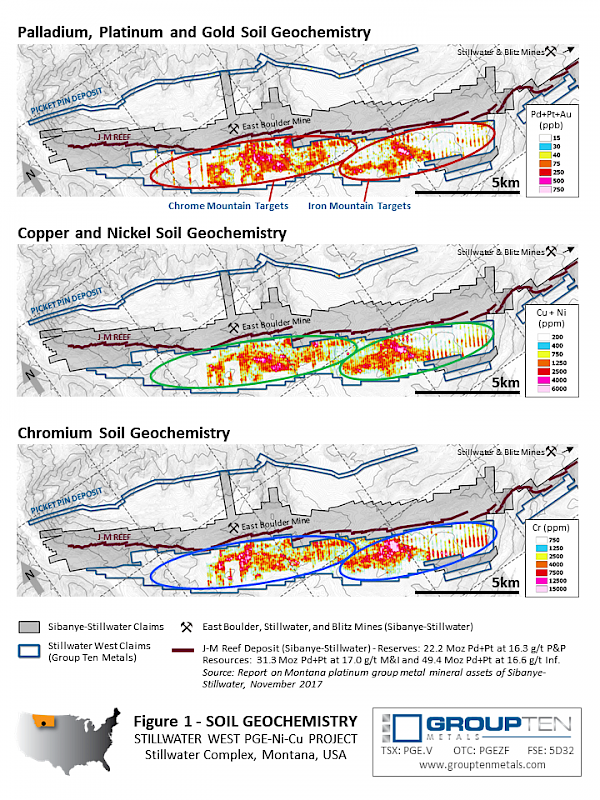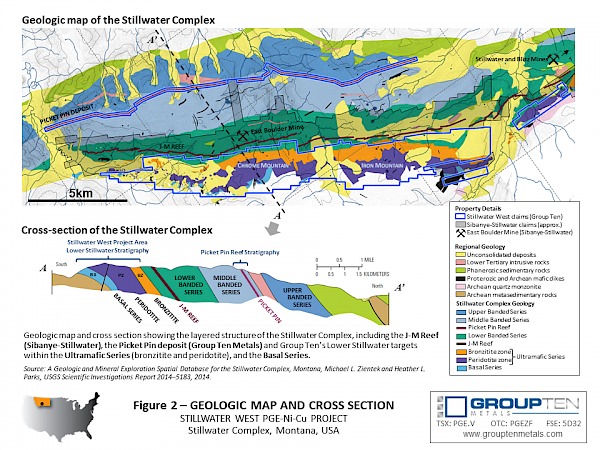January 10, 2018 – Vancouver, BC – Group Ten Metals Inc. (TSX.V: PGE; US OTC: PGEZF; FSE: 5D32) (the “Company” or “Group Ten”) is pleased to announce that it has identified an extensive area of highly elevated platinum group elements (PGE), nickel, copper and chromium in soils at its Stillwater West project, in south-central Montana. The highly anomalous soil values, which cover the Chrome Mountain and Iron Mountain target areas and measure approximately 10km and 8km long respectively, are up to 2km in width with grades exceeding 100 ppb palladium, platinum and gold, 1,250 ppm nickel and copper, and 4,000 ppm chromium. The soil anomalies, shown in Figure 1 below, cover approximately 18 kilometers (11.2 miles) of strike length over the lower Stillwater Ultramafic and Basal Series stratigraphy and include more than 13,500 soil assays. Importantly, the correlations of these soil values with mineralization in the Basal and Ultramafic zones of the lower Stillwater Complex, as shown in Figure 2, demonstrate that soils are a highly effective tool for targeting PGE and Ni-Cu deposits in the district.
Group Ten further announces the acquisition of an additional 51 claims at the Stillwater West project, expanding the Company’s holdings to 44 square kilometers (17 square miles) covering the lower Stillwater Complex. The Stillwater West project now totals 539 claims adjoining, and adjacent to, Sibanye-Stillwater’s high-grade Stillwater PGE mines which occur along the J-M Reef; one of the world’s largest and richest PGE deposits with a Measured and Indicated resource of 31.3 million ounces at a grade of 17.0 grams per tonne (g/t) Pt+Pd, plus an additional 49.4 million ounces at 16.6 g/t Pt+Pd in Inferred resources1, and over 12 million ounces Pt+Pd historic production to date at similar grades2.
The Stillwater Complex is a layered mafic-ultramafic intrusion recognized as one of the top regions in the world for PGE-nickel-copper mineralization, alongside the Bushveld Complex and Great Dyke in southern Africa3. Work at Group Ten’s Stillwater West property has identified three broad deposit target types including “Reef Type” high-grade PGE-Ni-Cu deposits, disseminated PGE-Cr-Ni-Cu deposits, and magmatic sulphide-related “Contact Type” PGE-Ni-Cu deposits.
Group Ten’s Picket Pin deposit in the upper portion of the Stillwater Complex is a Reef Type deposit similar to Sibanye-Stillwater’s J-M Reef deposit, with high-grade PGE mineralization associated with nickel and copper sulphides. These Reef Type deposits are similar in style to the Merensky Reef in the Bushveld Complex in South Africa, which hosts some of the world’s largest and highest-grade PGE deposits. Group Ten’s claims covering the lower Stillwater Complex stratigraphy include the Chrome Mountain and Iron Mountain target areas, which show potential for much larger-scale disseminated and high-sulphide PGE-nickel-copper type deposits, potentially similar to the lower Bushveld Complex.
At the Chrome Mountain target area, a newly-recognized style of PGE mineralization is associated with disseminated chromite over broad stratigraphic intervals tens or hundreds of meters in thickness. Host rocks are complexly textured Ultramafic Series lithologies that are locally pegmatoidal and have features suggesting the presence of magmatic breccias. This type of mineralization has not been previously recognized in the Stillwater Complex and is spatially-associated with the highest PGE-Ni-Cu-Cr values in soils at Chrome Mountain.
At the Iron Mountain target area, mineralization is thought to be Contact Type, being magmatic sulphide-hosted PGE-Ni-Cu hosted by lower Stillwater Ultramafic and Basal Series rocks and immediate footwall lithologies. Primary targets are accumulations of PGE enriched Ni-Cu sulphides occurring close to the base of the intrusion that are laterally extensive and up to several hundreds of meters thick. Mineralization is often associated with xenoliths and rafts of country rock, suggesting their interaction could have provided a trigger for sulphide deposition. Comparable deposits may include the Platreef, Waterberg and Mogalakwena mines in the Bushveld Complex3. The Iron Mountain target and much of the lower Ultramafic and Basal Series along strike have significant potential for deposits of this type and appear to be associated with the elevated PGE-Ni-Cu values in soils over this part of the stratigraphy.
President and CEO Michael Rowley stated, “We are very excited about the size and strength of the soil anomalies for the platinum group elements and their association with nickel, copper and chromium over such a broad area, which clearly indicates the presence of a much larger, metal-rich system than was previously recognized in the lower Stillwater Complex stratigraphy. Soil geochemistry has been shown to be very effective tool at identifying potential deposit locations within the complex and we expect to follow-up with additional work during the 2018 field season. The Company looks forward to issuing additional geo-technical releases in Q1 which will further highlight the potential at our Stillwater West project. More information on our ongoing compilation work and planned 2018 exploration can be found in our updated corporate presentation on our website at http://grouptenmetals.com.“
About Group Ten Metals Inc.
Group Ten Metals Inc. is a Canadian mineral exploration company focused on the acquisition and development of high-quality platinum, palladium, nickel, copper and gold exploration assets in North America. The Company’s holdings include the Stillwater West PGE-Ni-Cu project adjacent to Sibanye-Stillwater’s high-grade Pd-Pt mines in Montana, the Kluane Ni-Cu-PGE project adjacent to Nickel Creek Platinum‘s Wellgreen deposit in the Yukon Territory, and the Black Lake-Drayton Gold project in the Rainy River district of northwest Ontario.
Note 1: Public production records from 1992 to present.
Note 2: Report on Montana Platinum Group Metal Mineral Assets of Sibanye-Stillwater, November 2017, Measured and Indicated Resources of 57.2 million tonnes grading 17.0 g/t Pt+Pd containing 31.3 million ounces and 92.5 million tonnes grading 16.6 g/t containing 49.4 million ounces.
Note 3: Magmatic Ore Deposits in Layered Intrusions—Descriptive Model for Reef-Type PGE and Contact-Type Cu-Ni-PGE Deposits, Michael Zientek, USGS Open-File Report 2012–1010.
FOR FURTHER INFORMATION, PLEASE CONTACT:
Michael Rowley, President, CEO & Director
Email: info@grouptenmetals.com Phone: (604) 357 4790
Web: http://grouptenmetals.com Toll Free: (888) 432 0075
Quality Control and Quality Assurance
Mr. Mike Ostenson, P.Geo., is the qualified person for the purposes of National Instrument 43-101, and he has reviewed and approved the technical disclosure contained in this news release.
Forward-Looking Statements
This news release includes certain statements that may be deemed “forward-looking statements”. All statements in this release, other than statements of historical facts including, without limitation, statements regarding potential mineralization, historic production, estimation of mineral resources, the realization of mineral resource estimates, interpretation of prior exploration and potential exploration results, the timing and success of exploration activities generally, the timing and results of future resource estimates, permitting time lines, metal prices and currency exchange rates, availability of capital, government regulation of exploration operations, environmental risks, reclamation, title, and future plans and objectives of the company are forward-looking statements that involve various risks and uncertainties. Although Group Ten believes the expectations expressed in such forward-looking statements are based on reasonable assumptions, such statements are not guarantees of future performance and actual results or developments may differ materially from those in the forward-looking statements. Forward-looking statements are based on a number of material factors and assumptions. Factors that could cause actual results to differ materially from those in forward-looking statements include failure to obtain necessary approvals, unsuccessful exploration results, changes in project parameters as plans continue to be refined, results of future resource estimates, future metal prices, availability of capital and financing on acceptable terms, general economic, market or business conditions, risks associated with regulatory changes, defects in title, availability of personnel, materials and equipment on a timely basis, accidents or equipment breakdowns, uninsured risks, delays in receiving government approvals, unanticipated environmental impacts on operations and costs to remedy same, and other exploration or other risks detailed herein and from time to time in the filings made by the companies with securities regulators. Readers are cautioned that mineral resources that are not mineral reserves do not have demonstrated economic viability. Mineral exploration and development of mines is an inherently risky business. Accordingly, the actual events may differ materially from those projected in the forward-looking statements. For more information on Group Ten and the risks and challenges of their businesses, investors should review their annual filings that are available at www.sedar.com.
Neither the TSX Venture Exchange nor its Regulation Services Provider (as that term is defined in the policies of the TSX Venture Exchange) accepts responsibility for the adequacy or accuracy of this release.


